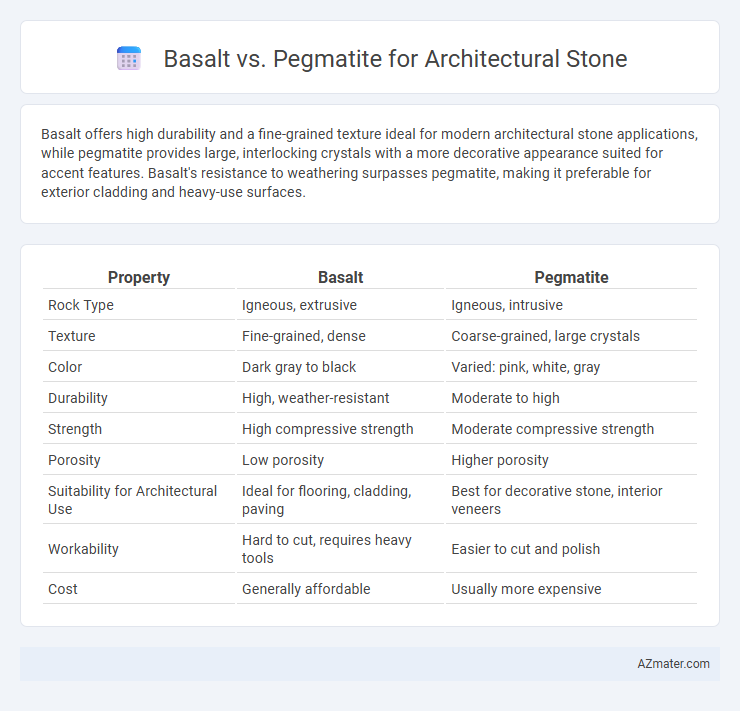Basalt offers high durability and a fine-grained texture ideal for modern architectural stone applications, while pegmatite provides large, interlocking crystals with a more decorative appearance suited for accent features. Basalt's resistance to weathering surpasses pegmatite, making it preferable for exterior cladding and heavy-use surfaces.
Table of Comparison
| Property | Basalt | Pegmatite |
|---|---|---|
| Rock Type | Igneous, extrusive | Igneous, intrusive |
| Texture | Fine-grained, dense | Coarse-grained, large crystals |
| Color | Dark gray to black | Varied: pink, white, gray |
| Durability | High, weather-resistant | Moderate to high |
| Strength | High compressive strength | Moderate compressive strength |
| Porosity | Low porosity | Higher porosity |
| Suitability for Architectural Use | Ideal for flooring, cladding, paving | Best for decorative stone, interior veneers |
| Workability | Hard to cut, requires heavy tools | Easier to cut and polish |
| Cost | Generally affordable | Usually more expensive |
Introduction to Basalt and Pegmatite as Architectural Stones
Basalt, a dense volcanic rock, offers exceptional durability and a fine-grained texture ideal for architectural stone applications requiring strength and weather resistance. Pegmatite, characterized by its coarse-grained texture and large mineral crystals, provides unique aesthetic appeal through its varied colors and patterns, making it highly sought after for decorative stone features. Both stones present distinct advantages in architecture, with basalt excelling in structural uses while pegmatite serves decorative and luxurious interior or exterior finishes.
Geological Origins: How Basalt and Pegmatite Form
Basalt forms from the rapid cooling of low-viscosity lava at the Earth's surface, resulting in fine-grained, dense igneous rock commonly found in volcanic regions. Pegmatite crystallizes during the final stages of magma cooling deep within the Earth's crust, developing large, coarse-grained minerals due to slow cooling and high fluid content. Understanding these distinct geological origins highlights basalt's durability and uniform texture versus pegmatite's unique, decorative mineralogy, influencing their architectural applications.
Mineral Composition and Physical Properties
Basalt, a fine-grained igneous rock primarily composed of plagioclase feldspar and pyroxene, offers high density and durability, making it ideal for architectural stone requiring strength and weather resistance. Pegmatite, characterized by its coarse-grained texture and large crystals of quartz, feldspar, and mica, provides unique aesthetic appeal and workability but is generally less dense and durable than basalt. The mineral composition of basalt contributes to its hardness and low porosity, while pegmatite's mineral diversity affects its color variation and ease of polishing, influencing their suitability for different architectural applications.
Aesthetic Qualities: Color, Texture, and Pattern
Basalt offers a sleek, uniform dark gray to black color with fine-grained texture, providing a modern and minimalist aesthetic suited for contemporary architectural designs. Pegmatite displays a diverse palette ranging from white to pinks and greens, accentuated by its coarse-grained texture and intricate crystal patterns that add natural elegance and visual complexity. The contrasting aesthetics make basalt ideal for bold, monochromatic schemes, while pegmatite suits designs seeking vibrant, textured focal points.
Durability and Weather Resistance
Basalt exhibits exceptional durability and weather resistance due to its dense, fine-grained structure, making it highly resistant to abrasion, chemical weathering, and freeze-thaw cycles. Pegmatite, with its coarse-grained texture and higher porosity, is less durable and more susceptible to weathering and physical degradation in exposed architectural applications. For long-lasting exterior cladding and paving, basalt is preferred over pegmatite because of its superior strength and minimal water absorption characteristics.
Workability and Installation Challenges
Basalt offers high durability and a fine-grained texture, but its hardness presents significant workability challenges, requiring specialized tools and expertise for cutting and shaping. Pegmatite, characterized by its coarse-grained structure and mineral diversity, is easier to work with due to its lower density but may have variable strength, affecting its stability during installation. Installation of basalt demands precise handling to prevent cracking, while pegmatite requires careful selection to avoid weaker mineral zones compromising the stone's integrity.
Sustainability and Environmental Impact
Basalt offers superior sustainability as it is abundant, requires minimal processing, and has excellent durability, reducing the need for frequent replacement in architectural applications. Pegmatite extraction can be more environmentally disruptive due to its rarity and the larger crystals that often require extensive quarrying, leading to greater habitat disturbance. The lower carbon footprint of basalt, combined with its natural thermal efficiency, makes it a more eco-friendly choice compared to pegmatite for sustainable architectural stone projects.
Cost Comparison and Availability
Basalt typically offers a more cost-effective option for architectural stone due to its widespread availability and lower extraction expenses, whereas pegmatite, being rarer and often found in limited locations, commands a higher price. The dense and durable nature of basalt makes it suitable for large-scale projects without excessive cost overruns, while pegmatite's unique mineral composition and aesthetic appeal justify its premium price in specialized applications. Regional availability heavily influences these costs, with basalt deposits found globally and pegmatite mines concentrated in fewer areas, affecting supply chain logistics and overall project budgeting.
Popular Applications in Architecture and Design
Basalt is favored in architectural stone for its durability and sleek, dark appearance, commonly used in flooring, cladding, and exterior facades to create modern, minimalist aesthetics. Pegmatite, characterized by its coarse grain and striking mineral inclusions, is often selected for decorative countertops, accent walls, and custom stone fixtures that emphasize natural textures and unique visual patterns. Both stones offer distinct advantages; basalt provides strength and uniformity, while pegmatite delivers visual complexity and luxury appeal in architectural design.
Choosing the Right Stone: Basalt vs Pegmatite
Basalt offers high durability, fine-grained texture, and a consistent dark color, making it ideal for modern architectural designs requiring strength and minimal maintenance. Pegmatite features large mineral crystals and a unique, decorative appearance with a variety of colors, suitable for statement pieces or accent walls where aesthetic appeal is paramount. Selecting between basalt and pegmatite depends on project requirements: basalt excels in structural applications, while pegmatite is preferred for artistic and visually striking architectural elements.

Infographic: Basalt vs Pegmatite for Architectural Stone
 azmater.com
azmater.com